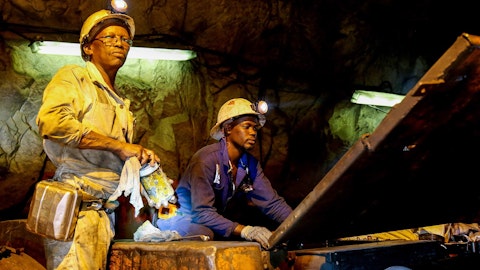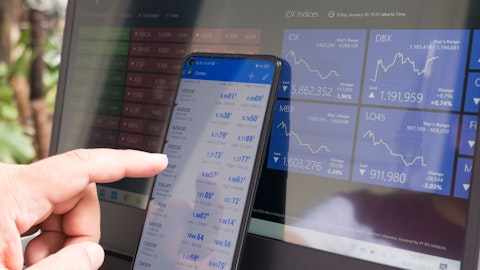And what we’re seeing in the depressed environment at the moment is that that inventory is being reduced, and there’s destocking taking place. That’s what depressing the price. None of the fundamentals have been impacted negatively. And, of course, inventory is finite, and we are already seeing a little bit more activity in the spot mark spot market from end users. So we remain positive and constructive regarding the PGM markets. Now, this is some company information, coupled with of course forecasts of others from a base data point of view. But it’s not, it’s very difficult to look at platinum and palladium as separate metals. And we initiated the substitution of palladium with platinum for very good reasons, and we’ll get to more of that later.
But the graph that you see here indicates, a base case market balance in red. It indicates through the gold bars, the — our view as a company of lower BEV growth. And, of course, you can see in terms of platinum and palladium looked at from a 2E perspective, the deficits increase from the base case just through that out into 2028. And when you look at supply rationalization, and you develop what we call a combined scenario of both BEV — lower BEV growth and supply rationalization. You can see why we remain constructive and bullish regarding these two metals with deficits all the way out in our view to 2030. In terms of rhodium, it’s also not too different. When you factor in our view of lower BEV growth, which we’ve maintained, as I’ve said, early on in the presentation for some time.
When you look at supply rationalization, and yes, we’re very mindful of the changes occurring in the fiberglass industry in China. You can see again, from a combined scenario point of view, rhodium remains only moves into a surplus in 2030. All of this bodes very well for the underpin to our PGM business. In addition to that, and I said I was going to come to this, we have as a company been driving, what we believe is innovative market development. Now I referred to the tri-metal catalyst work that we did with BASF in 2020. We felt that, the palladium, palladium demand had entered a phase where it was not sustainable in terms of the way we are mining. We looked at the international basket waiting and recognized that it was important to look at potential — the potential substitution of palladium with platinum.
Now today, we received many comments that you’ve actually undermined your own business. That’s not true because the reverse is also true as platinum, will increase in price that provides the underpin at a logical point in time for palladium to be substituted for platinum. And therefore, we are very confident that we’ve done the right thing from a sustainability point of view to ensure that our baskets are balanced. In addition to that, we’ve more recently embarked with Heraeus Precious Metals on two projects. I’m not going to go through these in detail, but the one is a ruthenium based catalyst for PEM electrolysis. And again that is to ensure that there are cheaper options for producing hydrogen and not having to revert to scarce iridium. The other one is we are exploring new applications for palladium in the hydrogen economy.
So, palladium has had in our view, very little market development investment. And we are following through on that. I’d like to now move onto what we believe is a very proactive focus and protection of the balance sheet, which is going to be a key focus for us in 2024. But before I go into the details, I think it’s important to just look at the external context in terms of the world we’re operating in. And again refer to the gray elephants. And the gray elephants, you would know are those highly probable, high impact, yet often ignored trends that are shaping the 2020s. And we spent quite a bit of time on talking about these gray elephants. Today, I really want to pick up on just a few. And we had noted previously the increasing trend in temperatures.
2023 was the warmest year on record. That’s accelerating this imperative for climate change. And of course, our metals are key and underpin what is necessary to protect the world from this runaway climate change. That’s not the focus of this, but I think the global trade patterns and supply chains are being significantly disrupted. And geopolitical developments are making deeper and deeper impacts. I referred to the destocking that’s currently taking place. I have not yet referred to palladium that we believe is coming from Russia via China at a discount and impacting and undermining, what is a commercial palladium price. Those are all patterns that come from the gray elephant of big squeezes. We are very cognizant of them and of course have strategies to deal with that.
I have said many times in these presentations, the issue of multipolarity or in another word, the deglobalization of the world is happening at an accelerated rate. Our positioning in Europe and the U.S. was not by chance. It was taking recognition of this multipolarity. And of course, those are markets that are short of these critical metals. Those are markets that we can support and jointly prosper in together with our stakeholders. I think when you look at the fact that 64 elections will take place, country elections that is in 2024. And you look at what is happening in the division between the East and the West. This is a very significant platform for angry people to express their discontent all over the world. And it is something that can really undermine very quickly, the underpins and the changes to market.




